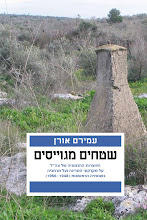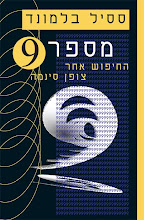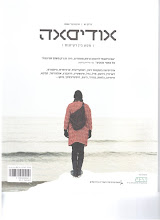ראייה
אנו
מגיעים כיום מתוך חללים סגורים המשובצים בקונגלומרט ענק. טווחי הראייה שלנו מובנים
למרחקים המוגבלים לבניינים מולנו ולמכוניות לפנינו. גבולות הגזרה שלנו מצומצמים
לרוחב הרחוב. רוב הראייה שלנו מתקיימת בחללים בגודל של חדר. אנו חיים ברצפים של
חללים דחוסים המכתיבים קצב והחזרי קצב משתנים, מהירים, מזוותים וקצרים. ביוצאינו
מהקומפלקס העירוני, בדרך כלל אנו נמצאים בתוך קופסת הרכב, כאשר אנו נעים לאורך
נתיב קווי מוגדר, ואז אנו מגיעים לחללים סגורים חדשים. כאשר אנו יוצאים מתוך המערך
הזה אל שטח פתוח , ואל נתיב שאינו ברור או אינו קיים, אל אופק לא תחום, אנחנו
נתקפים באופן מיידי בחרדה. אנו חשים חשופים, אנו חשים פגיעים, ואנו אכן כאלה.
יהיה לנו
מאד נוח בשלב ראשון אם ננסה להחיל את התפיסה המבנית שלנו על פני השטח. כך נוכל
להביט בערוץ כעל רחוב או כביש, ועל מפגש בין ערוצים כעל צומת. נוכל להסיק מסקנה
האם ישנה תנועה כבדה שכדאי להימנע ממנה כמו מים, שיחים צפופים, סלעים לא עבירים,
או, האם אנו יכולים להשתלב בגופינו ותנועתנו הרגלית בדרך. האם יש פתחי כניסה
לקירות ולגבעות בצדדים, או האם אלו הם מבנים חסומים. לאור תפיסה זאת נוכל לעשות
שימוש באופן הראייה הרגיל שלנו. בהתבוננות מסוג זה אנו מוצאים תחליפים, ואם תרצו,
תחליפי גמילה לתפיסת האופק, המרחב והריצוד שאנו רגילים ומכורים אליהם מהקומפלקס
העירוני.
אבל,
בסופו של דבר, אנו יכולים להשתחרר מהפחד ולהביט באופן חופשי אל מרחב גדול, לא
תחום. אנו מרחיבים את אופן הראייה שלנו. המשובים הקצרים המוטחים אלינו מהקירות הקרובים
בסביבה העירונית מספקים לנו אישור בלתי פוסק על מקומנו במרחב. המשובים האלו הופכים
להיות ארוכים ומועטים ביחס למה שאנו רגילים. כאן אנו יכולים לחוש יותר את יכולת
העמידה שלנו בכוחות עצמנו על פני הקרקע והמרחב הפתוח. זה אפשרי וקורה לכל אחד
ויותר מהר מששערנו.
בשלב ראשון המרחקים נראים אין סופיים. אנו מעדיפים לא להכיר במרחקים ועצמים שמעבר לטווחים שאנו רגילים אליהם, ואנחנו לא רואים אותם פשוטו כמשמעו. הם נותרים מחוץ לתפיסתנו. אבל בפרק זמן קצר יחסית של ימים אחדים אנו מסוגלים לקבל משוב ברור ובר שימוש ממרחקים של כמה קילומטרים, ולהשתמש במשוב זה באותה יעילות שאנו משתמשים במשובים הקצרים שבעיר. למעשה, האופק שלנו גדל. תפיסת עצמנו גדלה גם היא, ואכן, בשובנו לאחר פרק זמן ארוך בשטח, אל העיר, אנו חשים שהתקרות נמוכות יותר עלינו ולוחצות, וכנפי רוחנו נחבטות במשקופים הצרים. עלינו לקפלן, להשפיל את מבטינו ולהסתגל במהירות חזרה לתדר המהיר, לזמן המשתנה ולמרחקים הקצרים.
המדבר,
הים, הקוטב, הפסגות והחלל הם המרחבים הקיצוניים בעלי ההשפעה החזקה והם שונים
משטחים פתוחים רגילים הקרובים לתחומי המושב שלנו. בשטח הפתוח הקיצוני, למרות שאני
מחויב לחוקים נוקשים ולא סלחניים של חום, קור אויר ותנועה, אורך הגל של המשוב
מאפשר לנו להיות הרבה יותר חופשיים בקבלת ההחלטות שלנו. ביטוי הרגש שלנו יכול
להגיע בנחת יחסית עד סופו, וזאת בניגוד להפגזה העירונית המחייבת אותנו לפנות,
להחליט, לשלוף, ולבטא רגש חלקי מכיוון שעלינו להגיב מיד על המשוב הבא.
בשטח
הפתוח אנו יכולים לנוע ממצב של תגובה בלתי פוסקת ולחץ, למצב של רווחה, היענות,
ויצירת מרווח זמן מספיק המאפשר עיבוד רגשי, ניסוח והבנה. אולי ניתן לומר שככל שאנו
יוצאים החוצה רחוק יותר כך מתאפשר לנו להכיר את עצמנו יותר.
המערכת
הגופנית שלנו ניזונה ממשובים אלו ומאפסת את תדריה לפיהם. מקצבי השטח קובעים את
מקצבי הגוף. אנו נוכחים לדעת זאת לפי שינוי שעות השינה המתכיילות על פי שקיעת השמש
ועל פי זמני היציאות שלנו המתכיילות על פי הזריחה. מקצב נוסף בגוף המתכייל בהתאמה
לשטח, הוא מקצב הריצוד של שרירי העינים. למעשה, מקצב זה הוא ממשק ראשי בינינו לבין
סביבתנו ובעקבותיו מתכיילים גם יתר מקצבי הגוף כמו הנשימה, הדופק וחילוף החומרים.
אנו יכולים לומר למעשה שהשטח קובע את אופן ההתבוננות שלנו, ומכאן את אופן תפיסת
המציאות. ניתן לגזור מכאן השלכות תרפיות, הבנות על יחסיות של תפיסה, ובעיקר על
תפקיד הסביבה בהתנהגותנו. האדם הוא תבנית נוף מולדתו, נאמר. זאת אמת.
מצד שני
ניתן להפוך את כיוון המבט שלנו ולהתבונן בשטח האורבני כעל מערכת אקולוגית בעלת
אפיון מדברי. מדברי? אנחנו? והרי התרבות היא היפוכו של המדבר! ובכן, מסת הסלע המיוצרת המצטברת בצורות ומשטחים של קירות
בניינים, כבישים, ורחבות, מהווה אפיון מדברי. משובי קרינת חום ואור של משטחים חשופים, מהווה אפיון מדברי. נגר עילי
שייך לעולם זה, וגם נישות ירוקות בקרקעית ערוצים אשר אנו מוצאים אותם בגינות
בניינים ואיי תנועה. הבניינים והכבישים מייצרים חום. העיר חמה במידה משמעותית
מהסביבה הפתוחה. בועת חום ואור מתקיימת מעל שטח עירוני וניתן לזהותה ממרחקים על
ידי ענן האובך האופייני ביום וההילה בלילה. כמות האבק בעיר היא עצומה. פליטת
מכוניות, מכונות, ותנועה, בליית קירות, מתכת, נייר וחומרים אחרים מייצרת כמות אבק
הגדולה פי 200(!) מכמותו בשטחים פתוחים. אבק במשקל של מאות טונות מרחף, מונח ונע
עם זרמי אוויר על פני כל קילומטר מרובע אחד בשטח העירוני. שעות החשיפה מתייצבות
למקצב אחר על פי צל הבניינים, והצמחייה מתאפסת בהתאמה. אפשר לשער שדפוס מבני
זה, עם ייצור החום והשפעתו על האור, וזרימת המים ואי ספיגתם, דפוס זה בגודלו
הנוכחי כעיר בינונית מעצב את האקלים שלו כבועה אקולוגית בעלת גל השפעה מתפשט על
המרחב שבו העיר ממוקמת. כמו אגודל הנלחץ אל משטח וקווי הלחץ מסתמנים מסביב. ככל
שגדל הלחץ גדל הסימון. על פי ראייה זאת כל תוואי שטח הוא בעל השפעה על סביבתו.
יצירת תוואי החורג מקני המידה האקולוגיים של סביבתו מייצרת סביבה אקולוגית שונה.
ממש כמו אי הגדל והופך ליבשת. כך, גם אפשר לשער כי סכר אסואן משנה את סביבתו
במעגל הולך ומתרחב. הצללת מי הנילוס, היעלמות הסחף, האפיק המתחתר במים ההופכים
להיות מהירים יותר, הרס הדלתא, הדיונות על חופי מזרח הים התיכון, הכה רחוקים
מהנהר, נעלמות מחוסר חול הבא מהנהר, גשם במופע של שברי ענן ושיטפונות על פני חופים
אלו, פני הקרקע המשתנים בעקבות שיטפונות, מאגרי מים המתמלאים אחת לתקופות ארוכות
יותר, ניצול מים משתנה, אופי גידולים וצמחייה משתנה, מדד לחות אחר הן של האוויר
והן של הקרקע, סערות ברקים ושינויי המטענים החשמליים באוויר. למעשה המידה קובעת את
המקצב והחלל והיא אפיון הסביבה. מוזר הדבר שאנו נעים ושוהים בחללים ובריק המוגדרים
על ידי הצורות, אבל מושגינו מתייחסים רק לצורות ולגופים. הרי ברור הדבר שאם נתפוס
את החלל וכיווניו נוכל להבין את השפעתו של גוף או גופים בתוכו, מגמותיו, ואופיו של
השינוי המגיע בעקבות נוכחותו. לעיר של היום יש אופי מצוקי. קניונים במובן התצורתי,
שברים, העתקים, מעברים תלויים, נתיבי זרימה ותנועה תוקפניים, פינות מוסתרות של
מזון או מים, תצורות חברתיות של נברנים, מפרקים, וציידים, האופייניות לחיים בצל
שאינו של צמחייה, להקות בקנה מידה קטן, לעומת גדול בשטחים פתוחים. במבט מתרחק נוכל
לומר: הו, הרי המדבר שאנו מכירים מתבלה, נשחק, מתרכך. אולי ממבט זה אפשר לצפות את
מגמות השינוי של הערים בעתיד הרחוק מאוד. אבל זאת יש לדעת: התצורות האנכיות הללו
אופייניות למערכות צעירות, מערכות בהתהוות. ועוד, כל תצורה אכן מתפתחת,
ומתבלה.
Vision
These days we come from close
spaces, from cells in a huge conglomerate. Our eyesight is accustomed to ranges
confined by the buildings and cars around us. The scope of our vision is
limited to the width of a street. Most times we see spaces the size of a room.
We exist in sequences of crowded spaces that impose brisk, constantly changing,
angular rhythms and feedbacks. When we leave the urban area, we are usually
confined to the box that is a car that travels along a defined linear route,
and end up in other close spaces. Yet, when we set out to a field, on to an
uncharted or unknown path, towards the unbounded horizon, we are stricken with
anxiety. We feel exposed and vulnerable, and indeed – we are. At such times, it
will be helpful for us to apply our structure-oriented perception to the open
field: In this vein we can look at a streambed as if it were a street or a
highway, and at a meeting of two streambeds as if they were a junction. Now we
can assess whether there is heavy traffic to be avoided – fast flow of water,
thick bushes, impassable boulders or whether we can integrate our body and
movement and pace to the way. Whether there are openings in the surrounding
walls and hills or are they enclosed structures. Now that we have an
understanding of the situation we can apply our ordinary way of seeing things.
This type of seeing provides substitutes, or rather, offer alternatives for our
fixated perceptions of the horizon, space and flickering lights we have become
addicted to in the urban complex. Eventually we can let go of the fear and
freely look at the boundaryless, expansive openness. We expand our way of seeing. The brief relentless
feedbacks shoot at us from the nearby walls of the urban environment,
continuously validate our position. These feedbacks slow down. They become
longer and fewer compared to our everyday experience. Now we are able to stand
on our own two feet on the ground and in the wide-open space. It is possible
and it happens to everyone faster than we think.
Initially, the distances seem
infinite. We opt not to ignore objects and spaces beyond the scopes we are
accustomed to. We literally do not see them. The remain out of our perception's
reach. Yet after a few days, we are can receive clear and useful feedback from
a few kilometers away and utilize this feedback as skillfully as we do in town.
In fact, we have broadened our horizons. We have also broadened our sense of
self. Indeed, when we return to an urban
setting after spending a long time outdoors, we feel claustrophobic. The
ceiling seems lower, and pressing us in. The wings of our spirit are bashed by
the doorposts. We have to fold them,
lower our eyes and quickly readjust ourselves to the fast frequency, constant
changes and short distances.
The desert, the ocean, the
poles, mountain summits, and outer space, are the extreme spaces that exert the
strongest influence and are very different than the open spaces in our
vicinity. In the extreme spaces I am
subjected to the rigid, unforgiving decrees of temperatures and motion. But the
slow-paced, elongated feedbacks allow greater freedom in our decision making.
In contrast to the urban bombardment of feedbacks that forces us to turn,
decide, react, and express emotions partially in time to respond to the next
feedback, now we can then feel and express our emotion fully. In the wilderness
we can move from a state of incessant movement and stress to a state of
wellbeing and responsiveness that offers enough time to process our emotions,
formulate and understand.
Perhaps we can say that the
farther we venture, the more we learn about ourselves. Our body is fed by these
feedbacks and calibrate its frequencies in their rhythm. It is expressed in the
changes to our sleeping patters. Another bodily rhythm that adapts to the
outdoors is the contracting pace of the eyes' muscles. This pace is our primary interface with the
surroundings that other bodily rhythms like breathing, pulse, and metabolism
tune in to. In fact, we can say that our way of looking is determined by the
surrounding, and therefore on our perception of reality. We can now derive
therapeutic implications and insights about the relativity of perception.
Mainly it can tell us about the effect of the environment on our behavior. A
famous Israeli poet[1] once
wrote that "Man is but the imprint of his native landscape." This is true.
On the other hand, we can turn
our gaze around and look at an urban area as if it were a desert. A desert?
Could we? After all, civilization is the opposite of the desert! The rock mass
of the buildings' walls, roads and squares is a characteristic of the desert.
The heat and light radiated by barren spaces is a characteristic of the desert.
Overland flow belongs to
that world. Green niches that are found on the riverbeds of residential gardens
and traffic islands. Buildings and streets produce heat. The city is much
hotter than the wilderness. A bubble of heat and light encapsulates over urban
areas and can be detected from a distance by the cloud of haze in the day hours
and by a halo of light in the night time. The amount of dust in the city is
enormous: cars exhausts emissions, machines, traffic; walls eroding, metal,
paper and other materials. All produce dust in an amount which is 200-times
greater than that of an open area. Hundreds of tons of dust float, sink and
travel in the air over each square kilometer of an urban area. Exposure to the
sunlight is determined by the shadows cast by the building. The flora follows
suit. I am inclined to believe that this structure-made rhythm of
heat emissions, with its impact on sunlight and flow or drainage of water, in
its current size of a medium city, shapes its climate as an ecological bubble
that sends ripples of impact unto it surroundings.
It is like pressing a thumb
against a surface inducing ripples-marks in the circumference. The harder we press,
the more marks we make.
In the same manner, every feature
in the terrain has an impact on its surroundings. A feature that exceeds the
ecological scale of its environment transforms it - just like an island that
grows into a continent. So, I believe, that the Aswan Dam transforms its
environment in an ever-expanding ripple. The clearing of the Nile water, the
diminishing sedimentation, the deepening riverbed in the accelerating flow of
water. The Delta and the sand dunes along the eastern line of the Mediterranean
– so distant from the river – disappearing gradually from lack of river-fraught
sand, heavy brief sessions of rain and floods that change the surface. The
water reservoirs filling-up slower, the transformed use of water and thus the
transformed type of crops and vegetation, altered measurements of air and
ground humidity; thunderstorms and varying electric charges in the air. Actually,
space and rhythm are dictated by the surroundings. Curiously, we move and stay
in areas and spaces defined by shapes but our concepts refer just to objects
and bodies. If we conceptualize space and its directions, we would be able to
understand the effect that an object or objects have on the nature and patterns
of the ensuing change.
Modern cities are of like
precipices. A canyon-like formation of fault lines, planar fractures, movable
bridges, aggressive flows of water and traffic, hidden corners of food or
water, social formations of rodents, decomposers, and hunters, typical to life
in a non-flora-produced shade, small-scale packs compared to bigger-scale ones
in open areas. Looking back from a distance, we can say, that the desert as we
know it is being worn out, eroding, corroding and softening. Such a perspective
can perhaps tell us about the far into the future transformation patterns of
cities. But we must note that such vertical formations are typical to young
developing systems. Indeed, every formation is bound to evolve and erode.






















אין תגובות:
הוסף רשומת תגובה